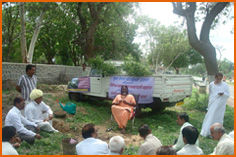| This involves the creation of artificial wetlands using aquatic plant root zone system to treat sewage waters upto tertiary levels for recycling to the irrigation and horticultural sector and possibly some industrial estates. |
|
|
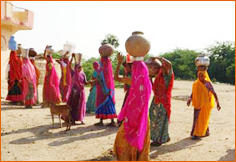 The system utilizes the roots of certain types of plants to provide sub-strates for the growth of bacteria, which utilizes the nutrients present in the effluents, and for the transfer of oxygen. The plants commonly employed are duckweed, water hyacinth, pennwort, etc. The plants have to be harvested regularly and about 20% to 25% plants should be removed at each harvest. These plants have a root system of rhizomes, containing thick hollow air passages, from which fine hair roots hang down. This root zone can support a very large population of aerobic microorganism, Bacteria, dominate the microbial population, which is expected to degrade most of the simpler organic materials i.e. those contributing to BOD. The fungi and actinomycetes, although fewer in number, have a wider range of hydrolytic activities and are expected to degrade many of the large molecules that contribute to the COD. The system utilizes the roots of certain types of plants to provide sub-strates for the growth of bacteria, which utilizes the nutrients present in the effluents, and for the transfer of oxygen. The plants commonly employed are duckweed, water hyacinth, pennwort, etc. The plants have to be harvested regularly and about 20% to 25% plants should be removed at each harvest. These plants have a root system of rhizomes, containing thick hollow air passages, from which fine hair roots hang down. This root zone can support a very large population of aerobic microorganism, Bacteria, dominate the microbial population, which is expected to degrade most of the simpler organic materials i.e. those contributing to BOD. The fungi and actinomycetes, although fewer in number, have a wider range of hydrolytic activities and are expected to degrade many of the large molecules that contribute to the COD. |
|
|
| The waste water encounters alternate aerobic and anaerobic microbial population which convert carbonaceous and to lesser extent nitrogenous and phosphatic, contaminants in the water to less polluting materials. Further microorganisms can form biofilms around lower stems, which can then trap particles suspended in the wastewater by absorption. |
|
|
| It is expected to achieve an effluent quality of 5-10 mg/l of suspended solids. |
|
|
| Goals Of Water Program By Paramhans Daati Ji Maharaj |
|
|
 In urban areas, rain water available from roof tops of buildings, paved and unpaved areas goes waste. This water can be recharged to aquifer and can be utilized gainfully at the time of need. The rain water harvesting system needs to be designed in a way that it does not occupy large space for collection and recharge system. A few techniques of roof top rain water harvesting in urban areas are described below. In urban areas, rain water available from roof tops of buildings, paved and unpaved areas goes waste. This water can be recharged to aquifer and can be utilized gainfully at the time of need. The rain water harvesting system needs to be designed in a way that it does not occupy large space for collection and recharge system. A few techniques of roof top rain water harvesting in urban areas are described below. |
|
|
 |
Imparting timely information regarding leakages, bursting of pipelines to Jal Board and eliciting quick response to ensure effective and efficient functioning of the water distribution system to all levels. |
|
|
 |
Educating all citizens of rural areas regarding water conservation methods and techniques to bring about greater water efficiency and thus bring about an effective increase in supply of filtered water. |
|
|
 |
Inculcating an awareness of the rapid depletion of ground water level and the need to harvest rainwater through simple rain water harvesting structures. |
|
|
| Components Of Water Program |


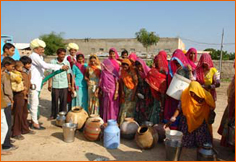 A step to conserve water is the step to secure future. The most essential among all the natural resources on earth is water. A drop of water is worth more than a sack of gold for the thirsty man. If each one of us make efforts to save water today, it will save us later. Water conservation is the most effective and environmentally sound method to fight global warming. Water conservation is what can reduce scarcity of water. It aims to improve the efficiency of use of water, and reduce losses and waste.
A step to conserve water is the step to secure future. The most essential among all the natural resources on earth is water. A drop of water is worth more than a sack of gold for the thirsty man. If each one of us make efforts to save water today, it will save us later. Water conservation is the most effective and environmentally sound method to fight global warming. Water conservation is what can reduce scarcity of water. It aims to improve the efficiency of use of water, and reduce losses and waste.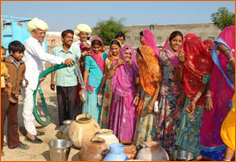 A step to conserve water is the step to secure future. The most essential among all the natural resources on earth is water. A drop of water is worth more than a sack of gold for the thirsty man. If each one of us make efforts to save water today, it will save us later. Water conservation is the most effective and environmentally sound method to fight global warming. Water conservation is what can reduce scarcity of water. It aims to improve the efficiency of use of water, and reduce losses and waste.
A step to conserve water is the step to secure future. The most essential among all the natural resources on earth is water. A drop of water is worth more than a sack of gold for the thirsty man. If each one of us make efforts to save water today, it will save us later. Water conservation is the most effective and environmentally sound method to fight global warming. Water conservation is what can reduce scarcity of water. It aims to improve the efficiency of use of water, and reduce losses and waste.




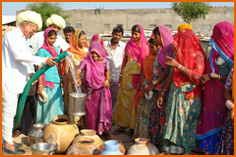
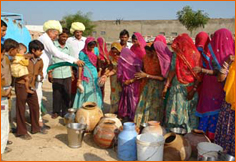 In rural areas, rain water harvesting is taken up considering watershed as a unit. Surface spreading techniques are common since space for such systems is available in plenty and quantity of recharged water is also large. Following techniques may be adopted to save water going waste through slopes, rivers, rivulets and drain line
In rural areas, rain water harvesting is taken up considering watershed as a unit. Surface spreading techniques are common since space for such systems is available in plenty and quantity of recharged water is also large. Following techniques may be adopted to save water going waste through slopes, rivers, rivulets and drain line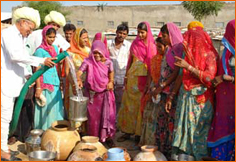 In urban areas, rain water available from roof tops of buildings, paved and unpaved areas goes waste. This water can be recharged to aquifer and can be utilized gainfully at the time of need. The rain water harvesting system needs to be designed in a way that it does not occupy large space for collection and recharge system. A few techniques of roof top rain water harvesting in urban areas are described below.
In urban areas, rain water available from roof tops of buildings, paved and unpaved areas goes waste. This water can be recharged to aquifer and can be utilized gainfully at the time of need. The rain water harvesting system needs to be designed in a way that it does not occupy large space for collection and recharge system. A few techniques of roof top rain water harvesting in urban areas are described below.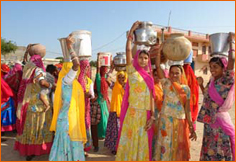 Steps should be taken to avoid dumping of sewage into the village ponds. Efforts need to be made to deepen these ponds with the dragline machines. Garbage and other waste methods should not be dumped into the ponds. The original purpose of village ponds was to give sustainability to adjacent wells and for cattle drinking, bathing, etc. As village are absorbed into urban areas with increasing reliance on tube wells, the ponds are becoming cesspools. These ponds can function as storage reservoirs and recharge areas subsequent to desiltation and improvement of their water quality. Following are some recommendations:
Steps should be taken to avoid dumping of sewage into the village ponds. Efforts need to be made to deepen these ponds with the dragline machines. Garbage and other waste methods should not be dumped into the ponds. The original purpose of village ponds was to give sustainability to adjacent wells and for cattle drinking, bathing, etc. As village are absorbed into urban areas with increasing reliance on tube wells, the ponds are becoming cesspools. These ponds can function as storage reservoirs and recharge areas subsequent to desiltation and improvement of their water quality. Following are some recommendations: The system utilizes the roots of certain types of plants to provide sub-strates for the growth of bacteria, which utilizes the nutrients present in the effluents, and for the transfer of oxygen. The plants commonly employed are duckweed, water hyacinth, pennwort, etc. The plants have to be harvested regularly and about 20% to 25% plants should be removed at each harvest. These plants have a root system of rhizomes, containing thick hollow air passages, from which fine hair roots hang down. This root zone can support a very large population of aerobic microorganism, Bacteria, dominate the microbial population, which is expected to degrade most of the simpler organic materials i.e. those contributing to BOD. The fungi and actinomycetes, although fewer in number, have a wider range of hydrolytic activities and are expected to degrade many of the large molecules that contribute to the COD.
The system utilizes the roots of certain types of plants to provide sub-strates for the growth of bacteria, which utilizes the nutrients present in the effluents, and for the transfer of oxygen. The plants commonly employed are duckweed, water hyacinth, pennwort, etc. The plants have to be harvested regularly and about 20% to 25% plants should be removed at each harvest. These plants have a root system of rhizomes, containing thick hollow air passages, from which fine hair roots hang down. This root zone can support a very large population of aerobic microorganism, Bacteria, dominate the microbial population, which is expected to degrade most of the simpler organic materials i.e. those contributing to BOD. The fungi and actinomycetes, although fewer in number, have a wider range of hydrolytic activities and are expected to degrade many of the large molecules that contribute to the COD. In urban areas, rain water available from roof tops of buildings, paved and unpaved areas goes waste. This water can be recharged to aquifer and can be utilized gainfully at the time of need. The rain water harvesting system needs to be designed in a way that it does not occupy large space for collection and recharge system. A few techniques of roof top rain water harvesting in urban areas are described below.
In urban areas, rain water available from roof tops of buildings, paved and unpaved areas goes waste. This water can be recharged to aquifer and can be utilized gainfully at the time of need. The rain water harvesting system needs to be designed in a way that it does not occupy large space for collection and recharge system. A few techniques of roof top rain water harvesting in urban areas are described below.